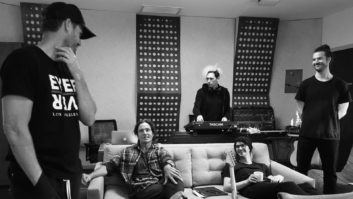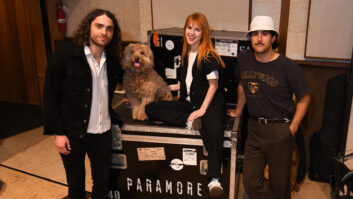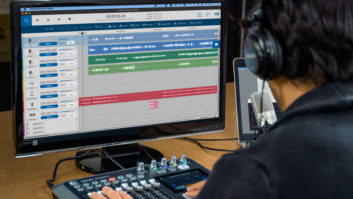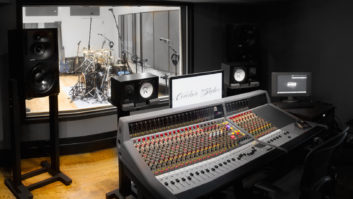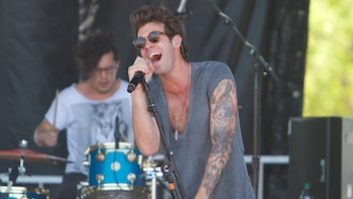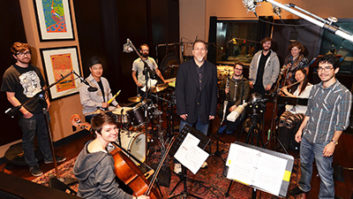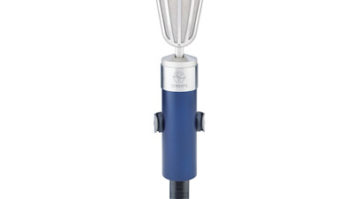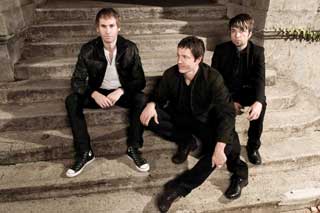
L-R: Brad Hargreaves, Stephan Jenkins and Tony Fredianelli of Third Eye Blind
Many, if not most, musicians have some sort of recording setup in or near their home. But it’s a rare few artists who have the chance to set up their gear inside a historic Victorian-era mansion in one of San Francisco’s toniest neighborhoods. Third Eye Blind frontman Stephan Jenkins got that opportunity when a friend not only offered up his “chamber room” — a massive three-story ballroom designed for opera singers and chamber orchestras — as a recording space, but also let him turn the carriage house behind the mansion into a mid-sized recording studio. The band’s new album, Ursa Major, out this month on their own subsidiary of Sony/RED, marks the first full-length recording tracked and mostly mixed at the new space. It also marks their first album in nearly six years and the tenth anniversary of the band’s self-titled debut.
Third Eye Blind reached their (first) peak in the late 1990s. Their debut spawned five hit singles, including the alt-rock radio favorite “Semi-Charmed Life.” Their 1999 follow-up, Blue, sold more than 1.25 million copies in the U.S. alone. Unfortunately, the band’s next album, Out of the Vein, became a victim to a merger between their record label, Elektra Records, and Atlantic. With little support, the album floundered, and ultimately Elektra’s parent company, Warner Music, dropped the band in 2004. With that, the band took some time off. They just didn’t realize how much time would pass before reconnecting for another record.
While Jenkins, drummer Brad Hargreaves and guitarist Tony Fredianelli took a hiatus from each other, the music industry and its listening community morphed in all sorts of peculiar ways. The major labels lost some control while the independents gained ground. The Internet became the primary medium for discovering and (hopefully) purchasing new music, and social networking became the way to market that music and make “friends.”
Thanks to these new tools, Third Eye Blind did not go dormant. Their fan base remained active and even grew during the past few years, and their live shows continued to sell out thanks to a bevy of new fans that discovered the band on Pandora and iTunes.
Building on this virtual community, the group teamed with Indaba Music to launch “Studio Access” (www.indabamusic.com/studio_access/3eb), which gives fans and musicians inside access to the band’s creative process. There, Third Eye Blind posted stems of newly recorded tracks and invited fans to create their own mixes. The band then chose their favorite version of each track and posted them on their Website, and MySpace and Facebook pages. “There’s a huge community of musical, talented people, and I think the new music paradigm will allow more of these people to make a living in music,” says Jenkins. “A lot fewer people become billionaires, but more people make a living. Sounds good to me.”
Listening to their fans’ interpretations further inspired the trio to move forward on a wealth of new material. Almost immediately after Out of the Vein hit shelves in 2004, the band started writing — sometimes on a tour bus, other times during soundcheck. Over time, the band had compiled nearly two albums’ worth of song ideas, but plans to re-enter the studio repeatedly got put on the back burner in lieu of side projects and other personal and professional endeavors.
When Jenkins got the green light from his well-off friend to convert his carriage house into a studio, the real possibility of a new recording — and recording facility — came into view. “First, we went back through all of the hard drives over the past five years and made rough mixes of all of the versions of all of these songs,” says engineer Sean Beresford. “It was interesting to go back through three different versions of the same song, all very usable and all with cool ideas.”
While Beresford sorted through the archives, he also advised Jenkins as he focused on the studio’s design and equipment. Working with noted studio designer Chris Pelonis, Jenkins revamped the midsized space to include a spacious control room, a recording room that’s large and live enough for guitar overdubs or a cozy band rehearsal, and a well-appointed 6×6-foot amp closet. The bathroom can also double as a small iso booth.

Engineer Sean Beresford in the control room of Third Eye Blind’s converted carriage house studio
Photo: Paul de Benedictis
Jenkins kept the windows to allow for natural light but added another set of half-inch-thick panes for noise control. (Both in and out: Because the studio is located in a residential neighborhood, they have to keep things quiet. But just like every San Francisco neighborhood, cars and buses make it noisy.) Pelonis also designed a pair of custom main monitors for the facility, which Jenkins pairs with a set of Barefoot Micromain MM27s and, at the time of our visit, a pair of Focal studio monitors.
To equip the facility, Jenkins moved in his Helios Olympic Studio preamps, racks of Neve 1073s and 1081s, and a few compressors, but he knew he needed a desk more powerful than his old Helios 20-channel line input console from his former San Francisco studio, Morningwood. He also knew he wanted a console that he could keep well into the next decade. He turned to Beresford for advice. “Stephan kept referring to the excitement that he had making his first record with Eric Valentine, which was recorded on 2-inch tape and mixed on a Neve,” the engineer says. “He seemed to want to get back to more of an organic sound.”
Beresford led Jenkins to Wunder Audio president Mike Castoro, who was in the process of developing the WunderBar, a modular desk based on the company’s popular PEQ1 preamp/EQ modules, which feature Neve, API and Wunder stereo bus “flavors.” They got the first one built. “It’s basically a brand-new, ’70s-style console,” says Jenkins. “It’s all discrete.”
Fully equipped with the best of both worlds — WunderBar, vintage outboard gear, a Studer A827 2-inch machine and a Digidesign Pro Tools HD3 with Lynx Aurora converters and an Apogee Big Ben master digital clock — the band recorded drums, bass and some guitar parts to tape, and vocals and other guitar parts in Pro Tools. The band took advantage of the historic ballroom at their disposal by recording drums in the large live room, with 48 tielines connecting them to the studio more than 225 feet away — just past the fountain and flower garden. A video monitor above the console maintains visual connection.
Although the band intended to record live in the ballroom, cabling and soundproofing issues — as in, the ballroom has none and neighbors with very expensive houses live very close by — prevented that from happening the way they intended. “We ultimately recorded drums in the ballroom, and bass followed by guitar in the control room,” says Beresford. “We did, however, experiment with the best way to position in this room and with various miking techniques.”
Although the band tried out some new techniques, they generally aimed to keep the recording process technically straightforward. “We focused on keeping our priorities straight,” says Jenkins. “Is the song good? Is the feeling of the song in the fingers of the player, and are those fingers coming down on an instrument that has a timbre and tone that’s really working for that song? And is it recorded into the right amp or in the right room? We wanted to make this album as flat as it comes in the tracking process — as close to that initial impulse as possible.”
For the most part, however, Beresford stuck with standard miking techniques and choices. He used a Mercenary Audio KM69 for overheads, acoustic guitar, strings, cello, violin, percussion and piano. “It’s the most-used mic on the record,” he says. Other favorites are the AEA R88 ribbon mic and a vintage pair of Neumann U67s that Beresford used on drums and piano.
Beresford miked the drums with an AKG D 112 inside the kick, a Soundelux 195 FET outside of the kick, Shure SM57 and/or SM7 on the snare, an AKG 451 and sometimes an Earthworks QTC50 on the hi-hat, and Sennheiser 421s on the toms. For vocals, Jenkins sang through his trusted Telefunken ELA M 251, which he’s used on almost every record, and which Beresford paired with a Mercury M66 compressor.
With some of the rough mixes in place, Jenkins began seeking out “big-name” engineers to mix the record. In the meantime, Beresford, who began working with Jenkins and Co. as an assistant engineer in 2000, mixed “Non Dairy Creamer,” which appears on the band’s recently released Red Star EP. He then mixed the remaining songs on that disc, as well as six of the tracks on Ursa Major. Tony Hoffer mixed three songs and Chris Lord-Alge mixed two, including the catchy debut single, “Don’t Believe a Word,” which has the melodic drive of the classic Third Eye Blind songs of the past.
More than two years have passed since Beresford first sorted through those hard drives packed with song ideas, and the music forums have been ablaze with posts from fans wondering when Ursa Major will really see the light of day. Despite scheduling conflicts and other random delays, Jenkins emphasizes that the process really did go fairly smoothly, and he looks forward to greeting audiences old and new, both in person and on the Web. “Even though the making of this album has taken a long time, the actual recording went very quickly,” Jenkins says. “That’s a product of the confidence and spontaneity that we have taken on from this new group of fans.”
